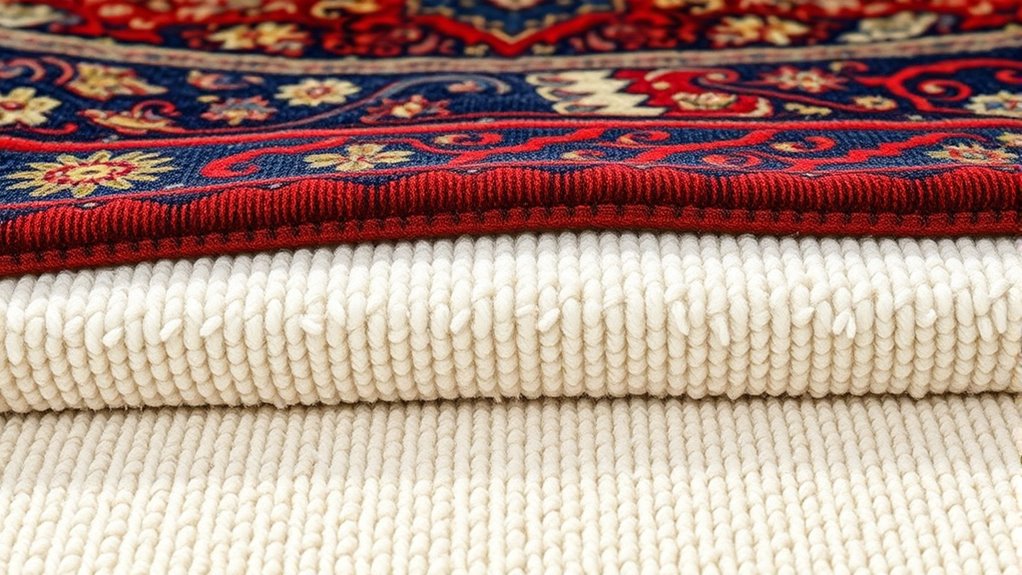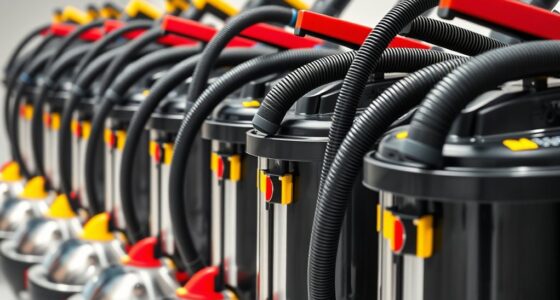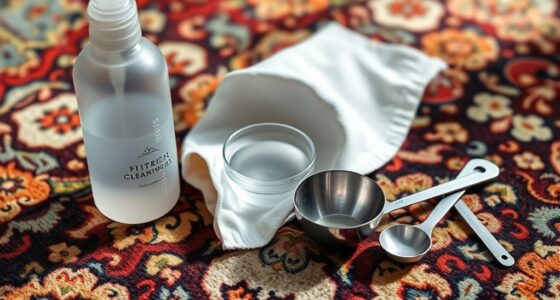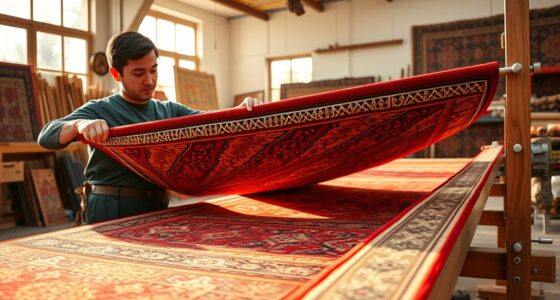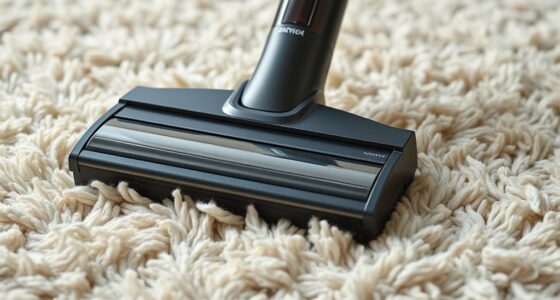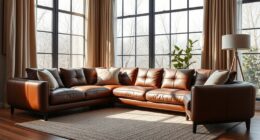Rug padding is essential for protecting priceless carpets, using advanced materials like felt, foam, and rubber to strengthen and cushion your rug while preventing moisture and slips through moisture barriers and anti-slip features. Proper padding absorbs shocks from daily foot traffic, reducing fiber wear and tear, and choosing the right thickness and density guarantees durability without damaging fibers. If you continue exploring, you’ll discover how to select the best padding for your specific carpet needs.
Key Takeaways
- Proper rug padding combines fiber reinforcement and moisture barriers to protect and extend the lifespan of priceless carpets.
- Shock-absorbing padding reduces fiber wear from foot traffic and impacts, preserving carpet beauty.
- Anti-slip technologies enhance safety and prevent shifting, safeguarding valuable carpets from damage.
- Padding thickness and density influence comfort, durability, and fiber protection; correct balance is essential.
- Selecting the right padding type based on carpet pile and material ensures optimal support and longevity.
The Composition and Materials of Rug Padding

The composition and materials of rug padding vary depending on its intended use and quality, but most types share common features. One key aspect is fiber reinforcement, which strengthens the padding’s structure, helping it maintain its shape and durability over time. You’ll often find fibers like felt, foam, or rubber, each offering different benefits. Additionally, moisture barriers are essential components that prevent spills, humidity, and water vapor from seeping into your flooring beneath the rug. These barriers help protect both your carpet and underlying surface from mold and damage. The combination of fiber reinforcement and moisture barriers ensures your rug stays in great condition longer, providing comfort and support while safeguarding your floors. Choosing the right materials depends on your specific needs and the level of protection required. Properly selected padding can also help reduce air pollution and improve indoor air quality by minimizing the buildup of dust and allergens.
How Shock Absorption Protects Carpet Fibers
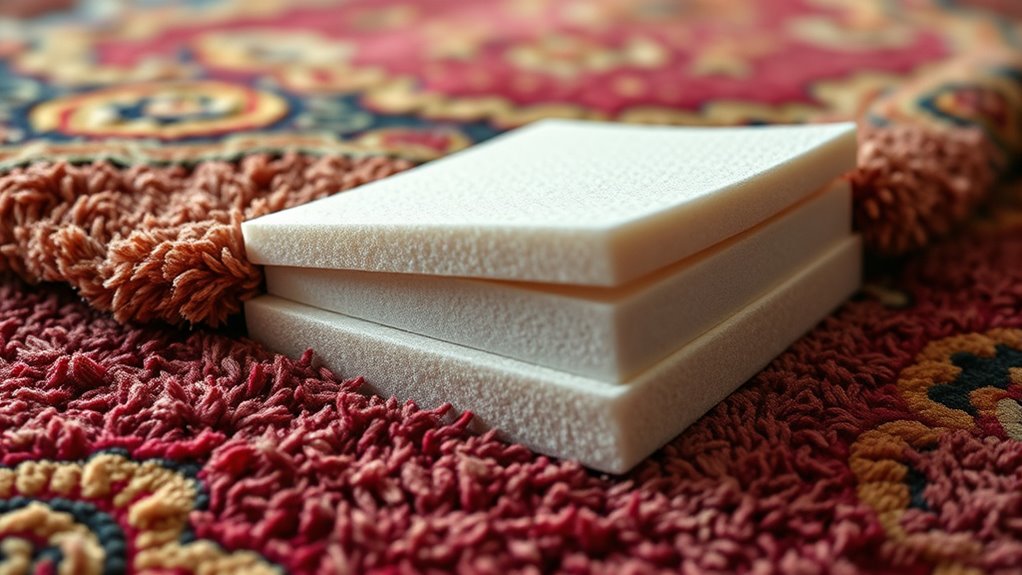
Shock absorption in rug padding plays a crucial role in protecting your carpet fibers from daily wear and tear. By absorbing impacts and reducing pressure, it prevents fibers from fraying or breaking over time. This fiber reinforcement ensures that your luxurious carpet remains vibrant and intact longer. Well-designed padding enhances padding durability, so it maintains its shock-absorbing qualities for years without flattening or deteriorating. When your rug can withstand foot traffic and minor impacts, the fibers stay stronger and less prone to damage. As a result, your priceless carpet retains its beauty and longevity. Proper shock absorption isn’t just about comfort; it’s a smart investment in preserving the integrity of your carpet’s fibers and ensuring lasting durability. Understanding resources and tools available for quality padding can further optimize your carpet’s protection.
Anti-Slip Technologies and Safety Features

Have you ever slipped on a wet or uneven rug? Anti-slip technologies and safety features keep you grounded. Rug padding with fiber reinforcement enhances grip, preventing slips. Moisture barriers block water from seeping in, reducing mold and slipperiness. These features work together to secure your rug safely. Incorporating slip-resistant materials into padding design further boosts safety and longevity.
The Impact of Padding Thickness and Density
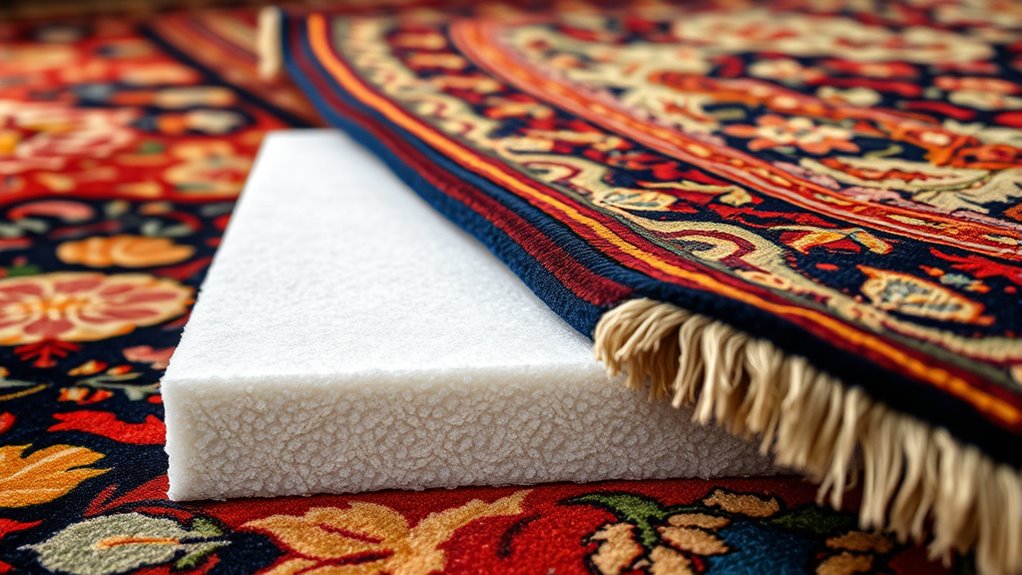
Padding thickness and density directly influence how well your rug stays in place and feels underfoot. Thicker padding provides enhanced cushioning comfort, making your steps softer and more comfortable. However, if the padding is too thick or too dense, it can reduce fiber longevity by putting extra stress on the carpet fibers, leading to faster wear. Conversely, thinner or less dense padding might compromise cushioning comfort and cause your rug to feel stiff or uneven. Striking the right balance ensures your carpet remains plush and comfortable while maintaining its durability over time. Properly chosen padding supports the fibers, prolongs their lifespan, and offers a cushioned feel that enhances your overall rug experience. Additionally, understanding the relationship between padding properties and carpet health can help you select the optimal padding for long-term satisfaction.
Choosing the Optimal Padding for Different Carpet Types
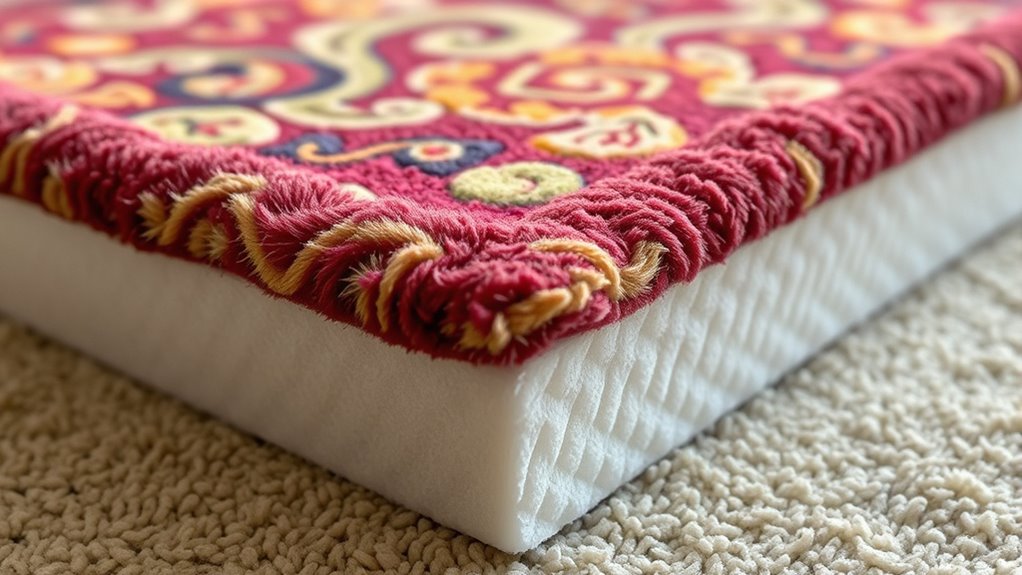
Choosing the right padding depends on your carpet type to guarantee ideal comfort and durability. For plush or high-pile carpets, opt for thicker, dense padding to support their softness and prevent crushing. For low-pile or looped carpets, thinner or firmer padding helps maintain their structure and appearance. Eco-friendly materials like natural rubber or recycled felt are excellent choices, offering sustainability without sacrificing performance. If you want to enhance your decor, consider decorative padding options that add visual appeal while providing cushioning. Always match padding thickness and density to your specific carpet type to prevent shifting, wear, or damage. Additionally, understanding the vetted options for carpet padding ensures you select high-quality materials that prolong the life of your carpet. By selecting the appropriate padding, you ensure your carpet remains beautiful and functional for years to come.
Frequently Asked Questions
How Does Rug Padding Influence Indoor Air Quality Over Time?
Rug padding impacts indoor air quality by trapping airborne allergens and moisture beneath your carpets. Over time, this can lead to mold growth if not properly maintained, releasing spores into the air you breathe. Regular cleaning and choosing the right padding help prevent these issues, ensuring that your indoor environment remains healthy and free from allergens and mold, ultimately improving the air quality in your home.
Are There Eco-Friendly Rug Padding Options Available?
Imagine you’re in a time machine and discover eco-friendly rug padding options today. Yes, you can choose recycled materials and biodegradable options that protect your priceless carpets and the environment. These eco-friendly paddings are made from sustainable sources, reducing waste and toxins. By opting for these, you guarantee your home stays healthier, and you contribute to a greener planet—without sacrificing quality or comfort in your cherished indoor space.
Can Specific Padding Materials Affect Carpet Dye Retention?
You might wonder if padding materials affect your carpet’s dye absorption and color fading. The answer is yes; certain padding materials can influence how well dyes stay vibrant. A breathable, moisture-resistant padding helps prevent dye leaching and fading, maintaining your carpet’s rich color. Choosing the right padding guarantees your priceless carpet retains its original beauty, keeping dye absorption balanced and reducing the risk of color fading over time.
How Does Padding Impact the Acoustic Insulation of a Room?
Think of your room as a drum, where padding acts as a muffler, softening the beats. Padding directly influences sound absorption and noise reduction, making your space quieter and more peaceful. It traps sound waves, preventing them from bouncing around, which reduces echo and external noise. By choosing the right padding, you create a cozy environment where sound is contained, transforming your room into a calm sanctuary.
What Are the Long-Term Maintenance Considerations for Different Padding Types?
When maintaining different padding types, you should regularly inspect for fiber degradation caused by wear and tear. You also need to guarantee mold prevention by keeping the padding dry and well-ventilated. For foam pads, replace them if they lose their shape or become damp. Natural fiber pads may require gentle cleaning to prevent mold. Proper maintenance extends the life of your carpet and preserves its comfort and appearance over time.
Conclusion
Think of rug padding as the silent guardian beneath your priceless carpet, whispering protection and stability. By choosing the right material and thickness, you’re not just preserving its beauty—you’re giving it a sanctuary to thrive. With the right padding, your carpet becomes a resilient masterpiece, standing tall against wear and tear like a fortress of elegance. Invest in this hidden hero, and watch your treasured rug flourish for generations to come.
